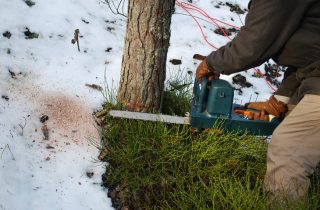When Albert and Betty Livingstone acquired their two acre compound below the southern edge of the Buderim escarpment in 1989, it was already heavily treed.
 The sought-after home sites on Monks Crescent above and to the rear of the estate changed hands many times as their shrubbery matured.
The sought-after home sites on Monks Crescent above and to the rear of the estate changed hands many times as their shrubbery matured.
But for the Livingstones’ foliage, the seven upslope allotments would still command a panoramic view to the south-east towards Moreton Island and the glasshouse mountains to the south.
Their vegetation had always provoked controversy. In February 2001, two 100-year-old figs were apparently poisoned, resulting in their eventual removal. Two years earlier, five trees had been felled without permission.
Then in November 2011, a new law – heaven sent for the uphill owners – arrived.
In that month, the Neighbourhood Disputes Resolution Act came into force, entitling a landowner whose view is diminished by tree growth, to apply for an order that their adjoining homeowner lop the offending trees.
That’s exactly what five of the Monks Crescent residents did, by seeking removal of the “substantial ongoing and unreasonable interference with the use and enjoyment” of their land which they claimed resulted from the “severe obstruction” of their views by the Livingstones’ greenery.
The first issues to be decided by QCAT member Barry Cotterell, were exactly what views existed from each home when each of the applicants bought in.
According to expert arborist Jeremy Young – engaged by all five – all had enjoyed “extensive views to the south and east” at the time of each of their purchases.
That opinion was substantiated by the tribunal-appointed arborist, Anthony Cockram.
He reported – identically in respect of each adjoining home by examining “photographic evidence provided on-site” – that the Livingstones’ trees “had not grown into an obstructing position at the time the dwelling was acquired by the applicant”.
Cockram did not however produce photographs said to have been provided on-site.
Judge Cotterell declined to follow either expert’s opinion and decided that he must look to the usual rules of evidence to ascertain the extent of each view. He required first-hand accounts from the owners or their neighbours – which were inevitably contentious – or photographs.
Michael and Helen Rice whose home at 13 Monks Crescent sat at around the midpoint of the Livingstones’ upslope east-west boundary, had been in occupation the longest, from June 1995.
But even they could only produce photographs dating back to 2001. The tribunal was not prepared to accept – without further substantiation – their evidence that in 1995, the view from No 13 took in Currimundi Reef and Moreton Island.
Rather, the Livingstones evidence that a mango tree near the boundary had predated their own occupation, was accepted. In any event, that tree “in an overall context” did not constitute “severe obstruction to the 180° vista looking East”.
However allowing a Bauhinia to grow to 11m and three camphor laurels (declared pests in Queensland) to reach up to 22m, did amount to an unreasonable interference.
The Livingstones were ordered to lop those trees – at their own expense – to a height of 2.5 m above ground level.
The applications by the other four adjoining owners were dismissed because tribunal was not satisfied of any interruption to their views from tree growth since the dates – from 2006 to 2014 – they had purchased their homes.
Laurence and Sylvia Pope were granted leave to be substituted as applicants for the previous owners of No 15 – Dieter and Christiane Klein who had been there since 2008 – but the tribunal took the view that the relevant date in respect of that application was (by reason of the change of ownership) the date the Popes moved in, in April 2014.
Rice v Livingstone [2014] QCAT 345 Member Cotterell 15/07/2014




0 Comments